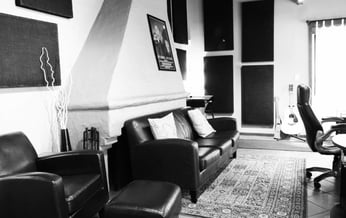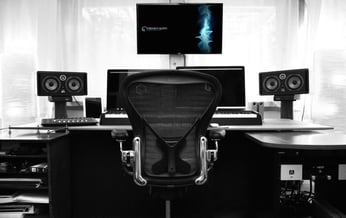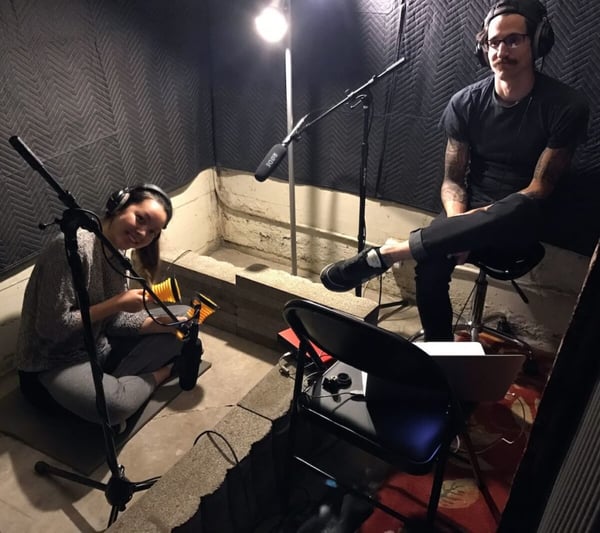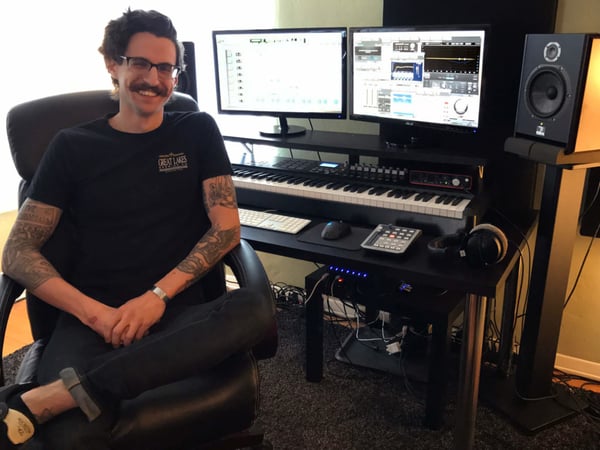The Pro Sound Effects 'How I Work' series (inspired by Lifehacker) asks Hybrid Library users what inspires them and what tools and routines help them get work done from day to day.
We recently had the chance to catch up with Hexany Audio, a Los Angeles-based audio team specializing in original music and sound for games, VR and interactive media. Their credits boast a variety of games from AAA to indie (Family Guy™: Back to the Multiverse, Disney Infinity, Meridian: Squad 22) as well as trailers, ads, and corporate branding for huge companies (Coca-Cola, AMC Theatres, Ford).
Joining us for an interview was Justin Hollis, Hexany's "master sound designer, Pro Tools ninja, and go-to nerd for all things sound." We discussed time-saving tips, his experience working on the reboot of the classic King's Quest game series, and how the team’s communication at Hexany has contributed to their success.
Can you tell me about your background and how you got the gig working with Hexany Audio?
I went to Drexel University in Philadelphia for Music Industry Technology, and I've been doing audio in various capacities (music recording, post production, indie games, etc.) as either a freelancer or at studios since about 2010. My main goal had always been to work specifically in game audio though, so when I found out that Hexany was looking for a new sound designer, I applied immediately. For reasons I still don’t fully understand, they decided to take a chance on me and before I knew it I was packing everything I owned into my truck and hauling it across the country to LA. Jokes aside, it’s been great so far; I’m extremely lucky to be a part of an awesome team of people and get to create cool content everyday while learning more and more about game audio/development.
Hexany seems to have been keeping busy and consistently working on great projects for years now. What specifically do you think is working for the company?
I think a big factor is our attention to detail and striving to make the best product possible, no matter how small or large the project might be. We all set a really high bar for ourselves here and aren’t internally satisfied until we’ve surpassed that expectation. We’re also a pretty diverse team in terms of individual skills and strengths, so we’re ready to tackle just about any project that comes our way.
We had the chance to visit your studio during GameSoundCon in September - how has working in such a unique space informed your creative work or client relationships?
I’m a big fan of the house-turned-studio; the team has grown a lot, (even just since I’ve started here) so we are starting to get a little cramped together and will be moving to a new space soon, but I actually think that it has helped keep us out of our “silos,” so to speak. I know I can walk around and get feedback, ask questions, or bounce ideas off of anyone here and they can all do the same. It also helps to keep us in the loop on all the projects everyone is working on, even when we might not be individually involved with them. I feel like clients appreciate that, when their projects are at least in the minds of the collective team, instead of being sectioned off to a single member or two.

What was your most recent project?
For the last 6 months, I've been finishing the final chapters of the rebooted King’s Quest series (Chapters 4, 5, & Epilogue) which have presented an interesting set of challenges. The series has been around for a while, so it has already developed a certain sound palette. I was picking up where another engineer had left off, so it was important that I really familiarize myself with the world of King's Quest when tackling the new chapters. I had to create sounds that felt like they were a part of the series instead of starting with a blank slate. *Spoiler warning to anyone that hasn't played Chapter 5 but plans to do so* There's a section in Chapter 5 that pays homage to the original series by teleporting you back to some classic levels, so it was a lot of fun mimicking the original sound effects and down-rezing the audio to make it match the different eras of those games.
What is a typical day like for you?
Honestly, the one thing I love most about this job is that there is no typical day. There’s always something new going on, which keeps the work fresh, while forcing you to be on your toes and learning with each new project. The type of work I end up doing the most of though would be capturing footage of the game we’re working on, designing sound effects to those video clips in Pro Tools, hooking those sounds up into Wwise if the project is using it as middleware, and keeping a detailed tracker of those created assets to help keep it all organized for ourselves and the dev team.
Where do you find inspiration for your sound design work?
Outside of hearing things out in the world, playing games, and watching movies/TV shows, I find it really helpful to seek out the wisdom and experience of other content creators out there.
There’s no shortage of meet-ups, talks, and conferences out here in LA but there’s also an incredible amount of information on the web (blogs, podcasts, YouTube channels, etc.) regarding all things audio that I find invaluable. Some of my go-to’s include SoundWorks Collection, the Beards, Cats and Indie Game Audio podcast, and Designing Sound. Learning how other folks do things makes me wonder how I can adapt or tweak those methodologies to my own workflow, since I’m always striving to be better and I feel like I still have so much to learn in this field.
What is one piece of advice you have for freelance sound designers interested/working in game audio?
Use the wealth of information on the internet to your every advantage and do so as often as possible: there are so many resources on the web that can help you learn the tools necessary for this field and they can really help you stand out among the other potential candidates trying to get the same positions as you. It can be hard to get “professional” experience with things like Wwise when you’re a freelancer since you’ll likely be working on lower budget projects that might not be able to afford the licensing cost for middleware integration. However, all the literature and tutorials that are openly available out there can at least get you familiar (if not relatively comfortable with) these tools, which will go a long way when you’re networking and looking for new opportunities.
What is your current studio/workspace setup like?
• Mac Pro 6-core, 32GB of RAM
• Pro Tools 12 HD
• Focusrite Scarlet2i4
• Focal Solo6 Be (Stereo)
• Akai MPK88 MIDI Keyboard
• Logitech G502: A great gaming mouse; it has 11 programmable buttons and can store/switch between multiple layouts, which comes in handy when jumping between Mac & Windows and having your hotkeys follow suit.
• Presonus Faderport: I love using faders and pan pots for writing my automation while I work and the Faderport is handy since it takes up less real estate on my desk than larger boards or controllers.
• Soundminer: Super fast searching and spotting sound effects and the pitching algorithm sounds great to my ears.
• iZotope RX5: I’d be lost without RX! The things I’ve been able to save or restore with it are nothing short of amazing and there are a lot of powerful, yet nuanced features/settings within it that might not be immediately apparent. It can take a little bit of time to fully understand and get really comfortable with everything RX can do, but it is a true game-changer in the world of audio.
What’s your favorite time-saving shortcut/tool?
Oh man, I’m not sure I can pick just one! I’ll narrow it down to a set for Pro Tools and a set for RX:
In Pro Tools, I like to have the various edit tools assigned to some of the buttons on my mouse so I can quickly jump between them. I find this method faster and more efficient than using the multi-tool but more importantly, it frees up the workload on my keyboard hand so I can do things like fades, trims, and copy/pastes much quicker, as well.
In RX, I like having the “process” function of each tab within a module routed to their own keyboard shortcut (ex. Attenuate, Replace, Pattern, and Partials+Noise have their own hotkey for the Spectral Repair module). I believe the default hotkey layout in RX isn’t set up this way (ex. The “Apply.Spectral Repair” hotkey will only process whatever tab is currently selected in the module) so you have to assign them yourself, but once you do and get used to the new workflow, you’ll find yourself flying through your dialogue edits, saving yourself heaps of time.
How has the Hybrid Library been useful in your work?
We get such a wide array of types of projects here, so it’s great to have the Hybrid Library at our fingertips to cover our every need for different types of sound effects. Whether it’s sci-fi, fantasy, action-adventure, first-person shooters, casual puzzles, you name it; I feel like I’ve been able to find almost everything I’m looking for. I’d actually be shocked if any sound asset I’ve made since being here at Hexany didn’t include something from the Hybrid Library.
What are your top 3 games or films from a sound perspective?
1. Shadow of the Colossus: I think this game is a great demonstration of how important sound is as a tool in storytelling. The huge, booming footsteps and rumbling vocalizations from the Colossi help sell the visual scale of how towering they are compared to your tiny character, while the dynamic music conveys a wide array of emotions during the different stages of your encounters with them.
2. The Metal Gear Series: I love this whole series. If I had to pick a single title from it, it’d probably be MGS2: Sons of Liberty but the series is full of cool sounds, engaging characters, and awesome soundtracks. Anyone who has played one of these games knows just how alarming that iconic “guard alert” sound effect can really be, because “remember Snake, this is a sneaking mission.”
3. No Country for Old Men: Skip Lievsay and his team did an incredible job supporting such a heavy and violent story with sound and almost no musical cues. There’s an unbelievable amount of detail in the foley, bgs, & hard effects, but they aren’t just detailed “for details sake,” so to speak. Each individual element feels like it was specifically chosen for the purpose of the narrative in that moment in the film, so it all feels very focused and deliberate. I like to rewatch it every couple of months and still find myself noticing things I hadn’t heard before.
Where's the best place for people to follow your work or contact you?
Website: Hexany - hexanyaudio.com | Personal - interritusaudio.com
Email: jhollis@hexanyaudio.com
IMDb: imdb.com/name/nm7475707
LinkedIn: linkedin.com/in/jthollis
This interview is How I Work #8. Read more interviews in the How I Work series here!
















